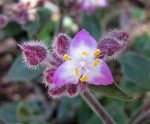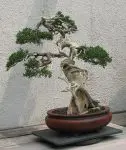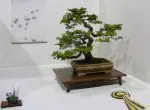This post contains affiliate links. If you buy something from one of our links we may earn a commission. Thanks
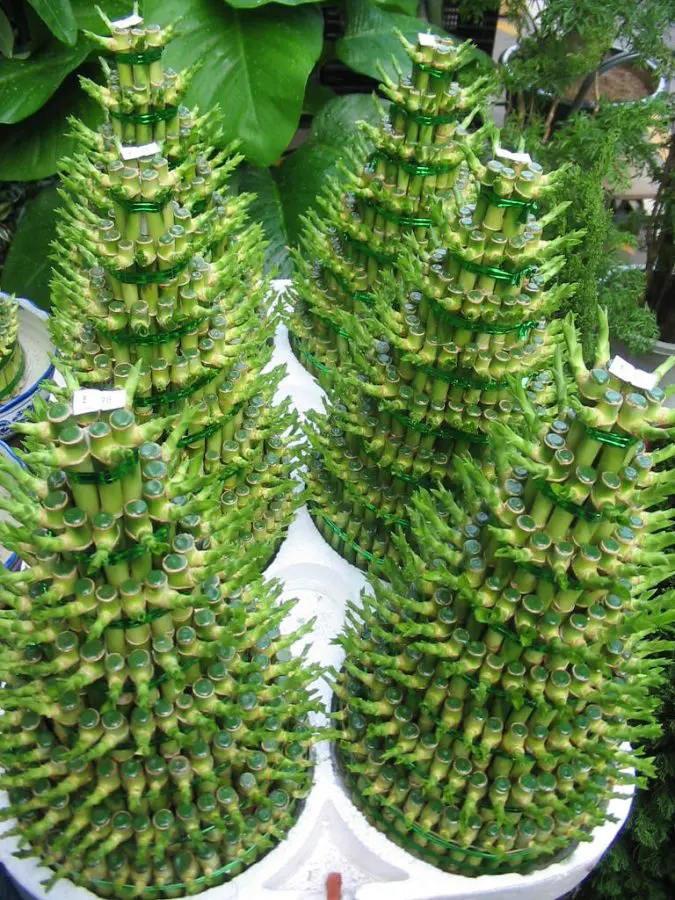
Looking for an easy and low-maintenance houseplant? Check out our guide to growing lucky bamboo in pots! Perfect for adding some green to your space.
To grow Lucky Bamboo in pots, choose a container and fill it with water until it covers the roots. You can also add rocks to it if you want. Place the pot in indirect sunlight and maintain a consistent water level. Fertilize sparingly, about every other month, using a diluted liquid fertilizer. Regular water changes help prevent bacterial growth.
Looking for a fun and easy way to bring some greenery into your home? Why not try growing lucky bamboo in pots?
It is also known as ribbon plant bamboo and Chinese water bamboo. Not only is this little plant low-maintenance, but according to feng shui, it’s also considered to bring good luck and positive energy into your space.
So, let’s get started and bring some good vibes into your home!
Introduction To Growing Lucky Bamboo In Pots
Buy your lucky bamboo plant here
Are you a plant lover looking for a unique addition to your collection? Or perhaps you’re searching for easy-to-care-for indoor plants that’ll add a pop of green to your living space?
Well, you’re in luck! In this guide, we’re going to explore the world of growing lucky bamboo in pots and give you some lucky bamboo care tips.
Not only is this little plant incredibly easy to care for, but it’s also thought to bring good fortune and positive energy into your home.
So, let’s dive into the wonderful world of lucky bamboo!
Explanation of lucky bamboo plant
Lucky bamboo is known as Dracaena sanderiana by its scientific name. And it is not actually a true bamboo at all but a member of the lily family.
It’s native to Cameroon in West Africa and thrives in warm, tropical climates.
Lucky bamboo is a popular houseplant due to its unique, twisted stalks and low maintenance requirements.
It’s also considered to be a symbol of good luck and prosperity in Chinese culture. The plant is believed to bring positive energy, good fortune, and happiness to its owner.
Growing Lucky Bamboo In pots
There are numerous benefits to growing lucky bamboo in pots. Firstly, it’s an incredibly low-maintenance house plant and requires very little attention.
Lucky bamboo can survive in a variety of light conditions, making it perfect for any indoor space.
Additionally, it’s a great air purifier, removing harmful toxins from the air and helping to keep your home healthy.
Lucky bamboo is also an affordable and easily accessible plant, making it a popular choice for those looking to add some greenery to their space without breaking the bank.
Finally, it’s a great way to incorporate a symbol of good luck and positivity into your home decor.
Choosing the right pot
Now that we’ve learned a bit about lucky bamboo, let’s talk about choosing the right pot to help your plant thrive.
The right pot can make all the difference in the growth and health of your lucky bamboo plant.
In this section, we’ll explore the different materials, sizes, and drainage requirements to consider when selecting the perfect pot for your lucky bamboo plant.
So, grab a cup of tea, and let’s get started!
Materials for the pot
When choosing a pot for your lucky bamboo plant, there are several kinds of pots made from a variety of materials to consider.
Common options include ceramic, glass, and plastic. Ceramic pots are a great choice for their durability and weight, which helps keep the plant stable.
Glass pots are perfect for showcasing the unique roots of the lucky bamboo plant.
Plastic pots are a more affordable option and can come in a variety of colors and designs to match your decor.
Ultimately, the choice of material comes down to personal preference and the overall aesthetic you’re trying to achieve.
Size of the pot
The size of your pot is also an important factor to consider. Lucky bamboo doesn’t require a lot of room to grow, but the size of the pot can impact its overall health.
As a general rule of thumb, choose a pot that’s 1-2 inches larger than the root ball of your plant.
A pot that’s too small can limit growth and lead to a root-bound plant. On the other hand, a pot that’s too large can lead to overwatering and root rot.
So, be sure to choose a pot that’s just the right size for your lucky bamboo plant.
Drainage hole requirement
Lastly, it’s important to consider the drainage hole requirement of your pot.
Lucky bamboo plants prefer moist soil, but they don’t like to be waterlogged. A pot with drainage holes at the bottom allows excess water to escape, preventing the soil from becoming too wet.
If your pot doesn’t have drainage holes, you can create some by drilling or punching holes in the bottom.
Alternatively, you can place a layer of gravel or rocks at the bottom of the pot to create a drainage layer.
Remember, proper drainage is essential to the health and longevity of your lucky bamboo plant.
Soil and fertilizers
Now that we’ve chosen the perfect pot for our lucky bamboo plant, it’s time to talk about soil and fertilizers.
Lucky bamboo is not too fussy when it comes to soil, but it does require some specific conditions to thrive.
In this section, we’ll explore the different soil types and fertilizers to use to keep your lucky bamboo plant healthy and happy.
So, let’s dig in and get our hands dirty!
Soil requirements
Lucky bamboo plants prefer slightly acidic soil that’s rich in organic matter.
You want to use the right type of soil for the best results. A good potting mix for lucky bamboo should be well-draining and retain moisture.
You can use a pre-made potting mix or create your own by mixing equal parts of peat moss, perlite, and sand.
Avoid using soil from your garden or compost, as it can contain harmful bacteria and insects that can harm your plant.
Fertilizer requirements
Lucky bamboo plants don’t require a lot of fertilizer, but they do benefit from occasional feedings.
A balanced liquid fertilizer is ideal for lucky bamboo. Fertilize your plant every two to three months during the growing season (spring and summer), and stop fertilizing during the dormant season (fall and winter).
Over-fertilizing can lead to burnt leaves and stunted growth, so be sure to follow the recommended dosage on the fertilizer label.
How to apply fertilizer
When applying fertilizer, it’s important to do so carefully to avoid burning the roots or leaves of your lucky bamboo plant.
Dilute the fertilizer to half the recommended strength, and pour it over the soil until it runs out of the drainage holes at the bottom of the pot.
Remember to always water your plant thoroughly before and after fertilizing to prevent any damage.
Slow release fertilizers
If you prefer a low-maintenance approach to fertilizing your lucky bamboo plant, you can also consider using slow-release fertilizers.
These types of fertilizers slowly release nutrients into the soil over time, reducing the need for frequent feedings.
Simply add the slow-release fertilizer pellets to the soil when planting your lucky bamboo, and they will continue to feed your plant for several months.
However, it’s important to note that slow-release fertilizers are not a substitute for occasional liquid fertilizers, as they do not provide an immediate boost of nutrients.
Instead, they are a convenient option for those who want to reduce the frequency of their fertilizing routine.
IV. Watering
Watering your lucky bamboo plant is a crucial step in its care routine.
While lucky bamboo is relatively easy to care for, it’s important to provide it with the right amount of water to keep it healthy and thriving.
In this section, we’ll cover everything you need to know about watering your lucky bamboo plant, including how often to water it, the best type of water to use, and how to tell if your plant is getting too much or too little water. So, grab a glass of water, and let’s dive in!
How often to water
Lucky bamboo plants thrive in moist soil but don’t like to sit in standing water.
As a general rule, water your lucky bamboo plant once a week, or when the top inch of soil feels dry to the touch.
However, the frequency of watering may vary depending on factors such as the temperature, humidity level, and size of your pot.
Always check the soil moisture level before watering to avoid overwatering.
How much water to use
When watering your lucky bamboo plant, use enough water to thoroughly saturate the soil.
Allow the excess water to drain out of the drainage holes at the bottom of the pot, and empty the saucer to prevent your plant from sitting in standing water.
Avoid overwatering, as this can lead to root rot and other problems.
Best water to use
Lucky bamboo plants are sensitive to chemicals found in tap water, such as chlorine and fluoride.
It’s best to use distilled or filtered water to avoid these chemicals.
Never use water that has been softened, as it contains too much salt.
If you must use tap water, consider using a tap water filter to remove harmful chemicals or use rainwater.
V. Lighting
Just like any other plant, lighting is an important factor to consider when growing lucky bamboo in pots.
Lucky bamboo plants thrive in bright indirect light and can even tolerate some shade.
In this section, we’ll cover everything you need to know about providing the right amount of light for your lucky bamboo plant, including how much light it needs, the best type of light, and how to tell if your plant is getting too much or too little light.
So, let’s shed some light on the subject!
The amount of light required
Lucky bamboo plants require bright indirect sunlight to thrive. This means placing your plant near a window with filtered light, or in a room with bright, indirect light.
Direct sunlight can scorch the leaves and cause damage to your plant. On the other hand, too little light can cause your lucky bamboo to become pale and spindly.
Light placement
When it comes to placing your lucky bamboo plant, it’s important to find the right balance between light and shade.
If you’re placing your plant near a window, make sure it’s not getting too much direct sunlight.
You can also rotate your plant every few weeks to ensure all sides are receiving equal amounts of light.
If your plant is not getting enough light, you may notice it becoming pale or growing toward the light source it is not getting enough light.
Consider using a supplemental grow light for your plant if natural light levels are low.
Artificial lighting options
If you don’t have access to bright, indirect light, you can also consider using artificial lighting options to keep your lucky bamboo plant healthy.
Fluorescent lights or LED grow lights can be a good option for providing the right type of light for your plant.
Place the lights above the plant and keep them on for 12-16 hours a day.
However, it’s important to note that artificial lighting is best used in addition to natural light, not as a substitute for it.
Maintenance and care
Congratulations on successfully growing your lucky bamboo plant in a pot!
But the work doesn’t stop there – like any plant, lucky bamboo requires ongoing maintenance and care to keep it healthy and thriving.
In this section, we’ll cover everything you need to know about lucky bamboo needs and maintaining and caring for your lucky bamboo, from pruning to repotting, and everything in between.
So let’s roll up our sleeves and get ready to give your plant some TLC!
Pruning and shaping
Pruning and shaping your lucky bamboo plant is important to keep it looking healthy and tidy.
You can use sharp scissors or pruning shears to trim off any yellow or brown leaves, or to shape your plant into your desired shape.
Make sure to cut at an angle to prevent water from pooling on the cut surface.
Don’t be afraid to experiment with different shapes and styles – lucky bamboo is a versatile plant that can be trained into many different shapes!
Pests and diseases
Lucky bamboo plants are generally resistant to pests and diseases, but they can still fall victim to common plant problems like spider mites, mealybugs, or fungal infections.
To prevent these issues, make sure to keep your plant clean and free of debris, and avoid overwatering.
If you do notice pests or signs of disease, you can try using an insecticidal soap or a fungicide to treat the problem.
It’s always a good idea to research the specific pest or disease affecting your plant to find the best treatment option.
Transplanting
Eventually, your lucky bamboo plant will outgrow its current pot and will need to be transplanted into a larger container.
You can tell it’s time to transplant when the roots start to become crowded and push against the sides of the pot.
When transplanting, make sure to use a pot that is one size larger than the current pot, and fill it with fresh potting soil.
Carefully remove the plant from its current pot, gently loosen the roots, and place it in the new pot.
Water the plant thoroughly and continue to care for it as normal.
Transplanting your lucky bamboo plant can help it continue to grow and thrive for years to come!
Growing Lucky Bamboo In Water
Have you ever heard of lucky bamboo? If not, you’re in for a treat!
Lucky bamboo is not only an adorable plant, but it also brings positive energy and good luck into your home.
One of the best things about growing lucky bamboo is that it’s incredibly easy to care for, especially if you choose to grow it in water.
In this blog section, we’ll go through everything you need to know about growing lucky bamboo in water, from getting started to troubleshooting common problems. So sit back, grab a cup of coffee, and let’s dive in!
Explanation of growing lucky bamboo in water
First things first, let’s talk about what lucky bamboo actually is.
Despite its common name, lucky bamboo isn’t actually bamboo at all, but rather a type of plant called Dracaena sanderiana.
This plant is native to Cameroon in West Africa and has become incredibly popular around the world due to its unique appearance and perceived positive energy.
Lucky bamboo typically has long, slender stems and bright green leaves that grow in a spiral pattern.
It’s also known for its ability to thrive in a variety of environments, including water!
Benefits of growing lucky bamboo in water
There are plenty of reasons why growing lucky bamboo in water is a great choice.
For starters, it’s incredibly low maintenance. Unlike other plants, lucky bamboo doesn’t require soil, which means you don’t have to worry about repotting it or dealing with messy soil spills.
Plus, because it grows so well in water, it’s a great option for those who don’t have access to a lot of natural light or who live in dry environments.
Additionally, many people believe that lucky bamboo brings positive energy and good luck into the home, making it a popular choice for feng shui enthusiasts and those looking to improve their overall well-being.
Getting Started
Okay, so you’re ready to start growing your own lucky bamboo in water. Awesome!
Before you get started, there are a few things you’ll need to consider in order to set yourself up for success.
In this section, we’ll cover everything you need to know about getting started with growing lucky bamboo in water, including choosing the right container, preparing the water, and selecting a healthy plant. Let’s get started!
Choosing the right container
When it comes to choosing a container for your lucky bamboo, there are a few things to keep in mind.
First and foremost, you’ll want to choose a container that’s tall enough to accommodate the length of your bamboo stems.
Additionally, you’ll want to make sure the container is wide enough to provide stability and prevent tipping.
Glass vases or jars are a popular choice for growing lucky bamboo in water, as they allow you to see the roots and add a decorative touch to your plant.
Just be sure to choose a container that’s made of non-toxic materials and is easy to clean.
Preparing the water
Preparing the right water is crucial for growing healthy lucky bamboo in water.
Tap water can contain chemicals that are harmful to your plant, so it’s recommended that you use filtered or distilled water instead.
You’ll also want to make sure the water is at room temperature before adding your plant, as extreme temperatures can shock the roots.
Lastly, some people like to add a little bit of liquid fertilizer to the water in order to provide extra nutrients for their plant.
Just be sure to follow the instructions on the fertilizer carefully and don’t overdo it!
Choosing a healthy lucky bamboo plant
When it comes to choosing a healthy lucky bamboo plant, there are a few things to look out for.
First, you’ll want to make sure the leaves are a vibrant green color and free of any discoloration or spots.
Additionally, you’ll want to check the stems for any signs of damage or discoloration.
Finally, pay attention to the roots – they should be a healthy white color and not mushy or discolored.
If you’re not sure what to look for, ask a knowledgeable plant expert for advice or do some research online to make sure you’re selecting a healthy plant.
How To Grow Lucky Bamboo In Water
Congratulations, you’ve successfully chosen a container, prepared the water, and selected a healthy lucky bamboo plant.
Now it’s time to start growing!
In this section, we’ll cover everything you need to know about growing lucky bamboo in water, including proper placement of the container, maintaining water levels and quality, and pruning and shaping your plant.
Whether you’re a seasoned plant grower or a beginner, we’ve got you covered. Let’s get growing!
Proper placement of the container
Choosing the right location for your lucky bamboo plant is key to its success.
Lucky bamboo thrives in bright, indirect light, so it’s important to find a spot in your home that provides enough natural light without exposing your plant to direct sunlight.
Direct sunlight can scorch the leaves and cause damage to the plant. Additionally, you’ll want to make sure the container is placed on a stable surface where it won’t be knocked over or bumped.
Maintenance of water level and quality
Maintaining the right water levels and quality is crucial for keeping your lucky bamboo healthy and happy.
Be sure to check the water level in your container regularly and add more water as needed.
As a general rule, the water level should be high enough to cover the roots but not so high that it’s touching the leaves.
It’s also important to change the water every two to four weeks to prevent the buildup of harmful chemicals and bacteria.
If you notice the water becoming cloudy or smelly, it’s time for a change!
Pruning and shaping the plant
Pruning and shaping your lucky bamboo plant is important for maintaining its health and appearance.
You can use sharp scissors or pruning shears to trim any yellow or brown leaves or stems.
Additionally, you can shape your plant by gently bending the stems into different shapes or using plant ties to guide the growth.
Lucky bamboo is incredibly flexible and can be trained to grow in a variety of shapes, from spirals to braids to hearts.
Just be sure not to overdo it – too much pruning or shaping can stress the plant and cause damage.
Troubleshooting Common Problems
Uh-oh, have you noticed some issues with your lucky bamboo plant?
Don’t worry, it’s not uncommon for plant parents to encounter a few bumps in the road when growing their plants.
In this section, we’ll cover some of the most common problems you might encounter when growing lucky bamboo in water, including yellowing leaves, mold growth, and root rot.
We’ll also provide some tips and tricks for troubleshooting and getting your plant back on track.
Don’t give up on your lucky bamboo just yet – let’s tackle these problems together!
Yellowing leaves
Yellowing leaves are a common issue with lucky bamboo plants and can be caused by a variety of factors.
One possible cause is over-fertilization, which can cause nutrient burn and damage to the roots.
Another potential cause is too much direct sunlight or exposure to cold drafts.
To address yellowing leaves, you can start by trimming off any damaged or discolored leaves with clean scissors or pruning shears.
Then, make sure your plant is not over-fertilized and adjust its placement to ensure it’s not exposed to too much sunlight or cold air.
Algae growth
Algae growth is another common problem that can affect lucky bamboo plants.
Algae growth can occur when the water is left standing for too long or if there’s too much light exposure.
While a little bit of algae is not harmful to your plant, excessive growth can indicate poor water quality and can stunt your plant’s growth.
To address algae growth, you can try changing the water more frequently and reducing the amount of light exposure to the plant.
You can also add a few drops of hydrogen peroxide to the water to help kill off the algae.
Root rot
Root rot is a serious issue that can occur when the roots of your lucky bamboo plant are overwatered or exposed to too much moisture.
Signs of root rot include a foul smell, soft or mushy roots, and wilting or yellowing leaves.
If left untreated, root rot can cause your plant to die.
To address root rot, start by removing your plant from the container and trimming away any damaged or rotten roots.
Then, let the plant dry out for a few days before replanting it in fresh water. Make sure to adjust your watering schedule to prevent overwatering in the future.
Final Thoughts On Growing Lucky Bamboo In Water
Congratulations, you’ve made it to the end of our guide on growing lucky bamboo in water!
By now, you should have a good understanding of the basics of growing lucky bamboo, from choosing the right container to troubleshooting common problems. Lucky bamboo is a beautiful and low-maintenance plant that can add a touch of green to any space.
With a little bit of care and attention, your lucky bamboo plant can thrive for years to come. We hope you found this guide helpful and that you feel confident in your ability to care for your lucky bamboo plant. Happy growing!
Recap of benefits of growing lucky bamboo in water
To recap, there are several benefits to growing lucky bamboo in water.
First, it’s an easy plant to care for, requiring minimal maintenance and attention.
Second, lucky bamboo can thrive in a variety of light conditions, making it a versatile choice for any space.
Finally, lucky bamboo is believed to bring good luck and positive energy to its surroundings, making it a popular choice for home decor and gift-giving.
Final thoughts and recommendations
Growing lucky bamboo in water is a fun and rewarding experience that anyone can enjoy.
Whether you’re a seasoned plant parent or a beginner, lucky bamboo is a great choice for adding a touch of green to your home or office.
Remember to choose a healthy plant, keep an eye on the water level and quality, and trim your plant regularly to keep it looking its best.
With a little bit of care and attention, your lucky bamboo plant will thrive and bring joy to your space for years to come. Next are some tips on bending Lucky Bamboo
Bending Lucky Bamboo
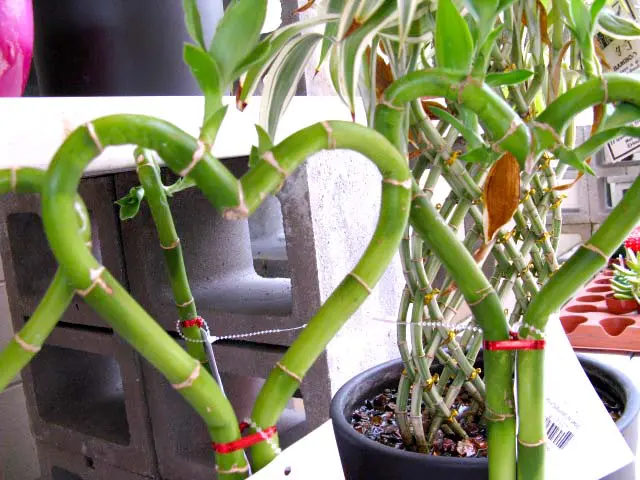
Lucky bamboo (Dracaena sanderiana) is a popular indoor plant that is believed to bring good fortune and positive energy into your home or office.
With its tall and slender stems, it is often used in Feng Shui practices to improve the flow of chi and promote good luck.
However, it’s not uncommon for lucky bamboo to become too tall or grow in unwanted directions, which can be frustrating for plant owners.
In these cases, bending the lucky bamboo can be a solution to keep it looking its best. Here’s what you need to know about bending lucky bamboo:
Choose the right time: The best time to bend your lucky bamboo is when it is actively growing, which is typically in the spring and summer months.
Avoid bending your bamboo during the winter when it is in a dormant state.
Be gentle:
Lucky bamboo is a delicate plant, so it’s important to be gentle when bending the stems.
Use your hands to gently bend the stem in the direction you want it to grow.
If the stem is too thick to bend by hand, you can use a piece of string to tie it to a support and gradually guide it in the desired direction.
Avoid breaking the stem:
When bending the stem, be careful not to apply too much pressure, as this can cause the stem to break.
If you hear a cracking sound, stop immediately and try a different approach.
Patience is key:
Bending lucky bamboo is not a quick fix. It can take several weeks or even months for the plant to fully adjust to its new position.
Be patient and check the stem regularly to make sure it is not under too much stress.
Prune if necessary:
If your lucky bamboo has grown too tall or has too many stems, you can prune it to promote new growth and keep it looking its best.
Use sharp scissors or pruning shears to cut the stem just above a node, which is where new growth will emerge.
In conclusion, bending lucky bamboo can be a useful technique for keeping your plant looking healthy and attractive.
With a gentle touch and a little patience, you can guide your lucky bamboo in the direction you want it to grow and enjoy its beauty for years to come.
Bending and twisting lucky bamboo for interest why and how
Bending and twisting lucky bamboo can create unique and interesting shapes, adding an artistic element to this already popular indoor plant.
Here’s why and how to bend and twist your lucky bamboo:
Why bend and twist lucky bamboo?
Lucky bamboo is naturally straight and tall, making it a popular choice for Feng Shui practices.
However, bending and twisting lucky bamboo can add visual interest and create a more dynamic appearance.
By manipulating the stems, you can create knots, curves, and other shapes that give your plant a unique and eye-catching look.
How to bend and twist lucky bamboo?
Choose the right time: The best time to bend and twist lucky bamboo is during its growing season, which is typically in the spring and summer months.
Use your hands: Lucky bamboo is a delicate plant, so it’s important to be gentle when bending and twisting the stems. Use your hands to gently shape the stem into the desired shape. If the stem is too thick to bend by hand, you can use a pair of pliers to gently manipulate it.
Use support: To help guide the stem into the desired shape, you can use support such as twist ties or string.
Simply tie the support around the stem and gently pull it in the direction you want it to go. Be careful not to apply too much pressure, as this can damage the stem.
Be patient: Bending and twisting lucky bamboo takes time and patience.
It’s important to make small adjustments over time, rather than trying to create the desired shape all at once.
Check the stem regularly to ensure it’s not under too much stress.
In conclusion, bending and twisting lucky bamboo can create a unique and interesting plant that adds character to your home or office.
By using your hands and support, you can gently manipulate the stem into a desired shape.
With patience and time, you can create a beautiful and artistic addition to your indoor plant collection.
Propagation
Have you ever wanted to expand your lucky bamboo collection without having to buy new plants?
Propagation is the way to go!
In this section, we’ll explore the exciting world of lucky bamboo propagation, including how to get a new lucky bamboo plant and what you’ll need.
With a little patience and some TLC, you can create new lucky bamboo plants from your existing ones, and watch your collection grow!
Propagation techniques
There are a few different ways to propagate lucky bamboo, including using stem cuttings or dividing the plant.
Stem cuttings are the most common method, and involve taking a healthy stem with several nodes and cutting it just below a node.
Make sure to use clean, sharp shears to prevent damaging the plant.
Dividing the plant involves separating the stems and roots of an existing plant into two or more smaller plants, which can then be potted separately.
When to propagate
The best time to propagate your lucky bamboo plant is during its active growing season, which typically occurs in the spring or summer.
This is when the plant is putting out the most new growth and will be better able to handle the stress of propagation.
Avoid propagating during the plant’s dormant season in the fall or winter, as this can lead to stress and may not be successful.
How to care for propagated cuttings
Once you’ve propagated your lucky bamboo cuttings, it’s important to care for them properly to ensure they develop into healthy, mature plants.
Place the cuttings in a container of water or in fresh soil, and keep them in a warm, humid location with bright but indirect light.
Change the water or mist the soil regularly to keep the cuttings hydrated, and avoid exposing them to direct sunlight or harsh drafts.
With proper care, your propagated cuttings will soon grow into beautiful, mature lucky bamboo plants!
Lucky Bamboo FAQs
Navigating the world of houseplants can be a bit challenging, especially when it comes to plants that hold cultural significance like Lucky Bamboo.
Knowing how to care for these plants not only enhances their lifespan but also their symbolic potency.
Below are some frequently asked questions to guide you in caring for your Lucky Bamboo, ensuring it thrives while possibly bringing some good luck your way.
Q: How long does lucky bamboo last for?
A: With proper care, Lucky Bamboo can last for years. Some have been known to live for a decade or more.
Q: Is lucky bamboo hard to keep alive?
A: Lucky Bamboo is relatively easy to care for. It needs indirect sunlight and should be kept in water.
Changing the water every week helps to keep it healthy.
Q: Does lucky bamboo need a lot of sun?
A: No, Lucky Bamboo prefers indirect sunlight. Direct sunlight can scorch the leaves.
Q: How many sticks of lucky bamboo for good luck?
A: The number of stalks has different meanings. For instance, two stalks symbolize love, while three or six stalks represent happiness and wealth, respectively. 5 stalks of lucky bamboo, represent balance, peace, harmony, and power
Q: Where is the best place to put my lucky bamboo?
A: Place your Lucky Bamboo in a spot with indirect sunlight. East-facing windows are often recommended. Avoid putting it in direct sunlight or areas with drastic temperature changes.
Conclusion
Congratulations on making it this far in your lucky bamboo-growing journey!
By now, you should have a good understanding of how to grow and care for lucky bamboo in pots, from choosing the right pot and soil to watering and lighting.
Remember to give your plants lots of love and attention, and don’t be afraid to experiment with different techniques and methods.
With a little practice, you’ll soon be a pro at growing lucky bamboo and enjoying the benefits of these beautiful and low-maintenance plants in your home or office.
To summarize,
In this guide to growing lucky bamboo in pots, we covered the following important points:
• Lucky bamboo plants are easy to care for and can be grown in a variety of pot materials and sizes.
• They require well-draining soil and regular fertilization, preferably with a slow-release fertilizer.
• Watering should be done regularly, using filtered or distilled water, and the plants should be placed in a well-lit area, but not in direct sunlight.
• Maintenance and care include pruning and shaping, identifying and treating pests and diseases, and transplanting if needed.
• Propagation can be done by cutting and rooting stems in water or soil.
Don’t be afraid to try your hand at growing lucky bamboo in pots!
With a little bit of care and attention, these beautiful plants can thrive in your home or office, providing both aesthetic and health benefits.
Remember, there’s no one “right” way to care for these plants, so feel free to experiment and find what works best for you and your lucky bamboo.
And who knows, you might even discover a green thumb you didn’t know you had!
Buy your lucky bamboo plant here
Read more about 20 Benefits Of Keeping Indoor Plants For Improved Lifestyle
Read more about Planting Lucky Bamboo In Rocks






